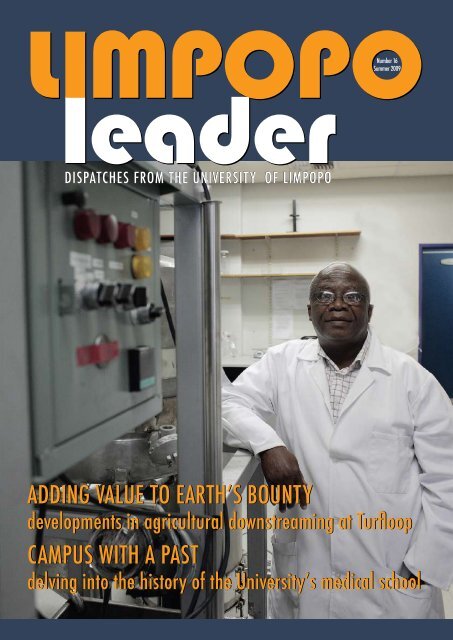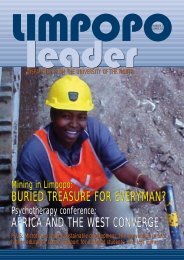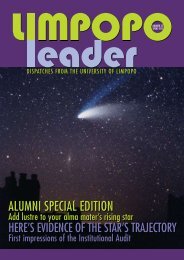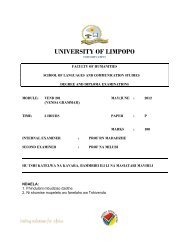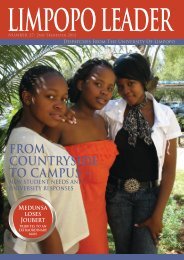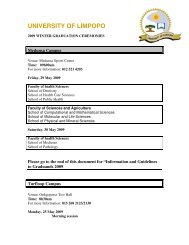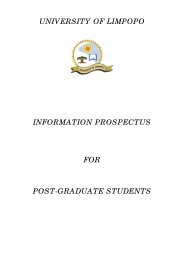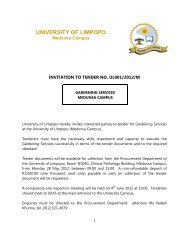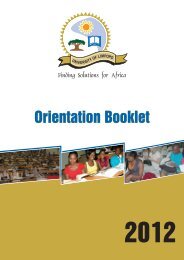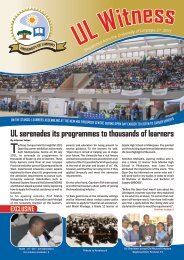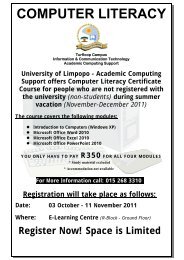Limpopo Leader - University of Limpopo
Limpopo Leader - University of Limpopo
Limpopo Leader - University of Limpopo
- No tags were found...
Create successful ePaper yourself
Turn your PDF publications into a flip-book with our unique Google optimized e-Paper software.
LIMPOPOIeaderDISPATCHES FROM THE UNIVERSITY OF LIMPOPONumber 16Summer 2009ADDING VALUE TO EARTH’S BOUNTYdevelopments in agricultural downstreaming at TurfloopCAMPUS WITH A PASTdelving into the history <strong>of</strong> the <strong>University</strong>’s medical school
What have you been reading lately?SUBSCRIBE SUBSCRIBE SUBSCRIBEto LIMPOPO LEADER and be informed by theprovince’s most dynamic magazineStudents Subscribe now and save 50%Subscribing to <strong>Limpopo</strong> <strong>Leader</strong> Magazine for ONE YEAR costsjust R50 per annum for Students & R100 per annum for Alumniand local subscribers!• Student subscriptions MUST include your student number• Subscribe by post and include your pro<strong>of</strong> <strong>of</strong> payment• Subscriptions can be paid directly to DGR Writing &Research’s account• Or by cheque made payable to DGR Writing & Research• Pro<strong>of</strong> <strong>of</strong> payment FAXED with subscriber’s full details to: (+27) 011 782 0335Account Details:Bank:Standard BankBranch:MelvilleBranch Code: 00-61-05Account Number: 002 879 336Account Name: DGR Writing and Research ccReference:Sub/ (+your initials & surname)Contact: Clare-Rose JuliusTel: (+27) 011 782 0333 Fax: (+27) 011 782 0335 Cell: 072 545 2366Email: info@developmentconnection.co.zaP O Box 2756, Pinegowrie 2123, Gauteng, South Africa
<strong>Limpopo</strong> <strong>Leader</strong> is published bythe Office <strong>of</strong> the Vice-Chancellor,<strong>University</strong> <strong>of</strong> <strong>Limpopo</strong>,PO Box X1106,Sovenga 0727,<strong>Limpopo</strong> Province,South Africa.HYPERLINK “http://www.ul.ac.za”www.ul.ac.zaEDITOR: David Robbins.Tel: 011-792-9951 or082-787-8099 ordgrwrite@iafrica.comADVERTISING:Clare-Rose JuliusTel: 011-782-0333 or072-545-2366EDITORIAL COMMITTEE:DK Mohuba (chairman)Daphney KgwebaneNorman NyazemaElizabeth LubingaDavid RobbinsGail RobbinsARTICLES: written by Janice Hunt:Campus with a past – page 4; FromTurbulence to Triumph – page 6;Looking back at Medunsa’s earlydays – page 7; News <strong>of</strong> the dayfrom Mendusa archives – page 8;Ancedotes and insights – page 10PHOTOGRAPHS: Liam Lynch: Coverpage; pages 1, 3 (not top photograph),pages 15, 19, 23, 25, 29,30 & 32 Medunsa PhotographicArchive: page 3 – top; pages 4, 5,6, 7, 8, 9, 12 on right & backcover; photographs fromPr<strong>of</strong>essor Len Karlsson: pencildrawing – page 10; page 12 onleft; photographs from The BiggerPicture; pages: 13, 20 & 21;photographs from David Robbins:page 17 & 27DESIGN AND LAYOUT:RED Advertising and Design StudioPRINTING: Colorpress (pty) LtdPRODUCTION MANAGEMENT:DGR Writing & ResearchTel: 011-782-0333 or082-572-1682dgrwrite@iafrica.comwww.dgrwriting.co.zaARTICLES MAY BE REPRINTED WITHACKNOWLEDGEMENTISSN: 1812-5468EDITORIALtOUR ANECDOTAL LOOK AT THE HISTORY OF THE DR. GEORGEMUKHARI HOSPITAL AND THE MEDICAL SCHOOL NEXT DOORBEGINS IN THIS ISSUE. The story is a remarkable one because it is soclosely bound up with the South African political narrative that playeditself out over the last few decades <strong>of</strong> the 20th century.Begun as part <strong>of</strong> an ‘antidote’ to black frustrations as manifested in theSoweto uprisings, the Medical <strong>University</strong> <strong>of</strong> Southern Africa had anuncertain beginning. Would it become a ‘bush university’, inferior toother medical schools? Or would it be able to hold it head up in suchillustrious company as the medical training <strong>of</strong>fered by the universities<strong>of</strong> Cape Town, Wits, Pretoria and the Free State? That the answer tothe second question is a definite ‘yes’ was not a foregone conclusion.The vicissitudes <strong>of</strong> fortune that were experienced by both medicalschool and attendant teaching hospital are well documented in thisissue. It’s a story <strong>of</strong> triumph – and it’s a story that will continue in ourAutumn 2009 issue. Contact us if you’ve got a story to tell and you’dlike to be included.There’s interesting coverage in this issue <strong>of</strong> the relevance <strong>of</strong> indigenousknowledge. The essential characteristic <strong>of</strong> the European Renaissancewas a rekindling <strong>of</strong> interest in the first flowering <strong>of</strong> western learningamong the ancient Greeks and Romans. The same process shouldbe happening in Africa, but the continent’s wisdom has tended tobe downgraded, first by the all-consuming ‘superiority’ <strong>of</strong> Europeanempires, and now by the equally consuming ‘modernity’ <strong>of</strong> the globalvillage. Key concerns in our coverage are: how to nurture indigenousknowledge and how to position it in modern educational practice.Also <strong>of</strong> interest is a collection <strong>of</strong> articles under the umbrella title <strong>of</strong>‘Adding value to Earth’s Bounty’, which examines the work being doneat the university to promote agricultural downstreaming in <strong>Limpopo</strong>Province. Read about Turfloop’s new Agro-Food Processing ResearchUnit, and about a Micro Brewer Brewery that has made anappearance in the Department <strong>of</strong> Biochemistry, Microbiology andBiotechnology. Then learn about the trials that are being conducted onan Ethiopian and East African plant that could introduce a bit <strong>of</strong>genuine green into petro-chemical products like plastics, PVC andepoxy resins.And there’s quite a lot more besides.NEXT ISSUELOOK OUT FOR PART TWO OF OUR SERIES ON THE HISTORY OFMEDUNSA (NOW THE MEDICAL SCHOOL ON THE GA-RANKUWACAMPUS OF THE UNIVERSITY OF LIMPOPO) AND THE ADJACENTDR. GEORGE MUKHARI HOSPITAL. There’ll also be more pr<strong>of</strong>iles <strong>of</strong>the new executive team: notably <strong>of</strong> the new Deputy VC andGa-Rankuwa campus Principal and the new executive dean <strong>of</strong> theFaculty <strong>of</strong> Health Sciences. Apart from that, there’ll be excitingcoverage <strong>of</strong> new developments on the Turfloop campus; and anexamination (based on research conducted by the Southern AfricanRegional Universities Association) <strong>of</strong> the fate and potential <strong>of</strong> postindependenceAfrican universities. Subscribe now to secure your copy.P A G E 2
IN THIS ISSUEcover picturePr<strong>of</strong>essor Emil Abotsi <strong>of</strong> the <strong>University</strong> <strong>of</strong> <strong>Limpopo</strong>’s Department <strong>of</strong>Biochemistry, Microbiology and Biotechnology in the Micro BrewerBrewery that has recently been installed on the Turfloop campus,courtesy <strong>of</strong> the South African Breweries (SAB). See the story onpage 24.p age 5:CAMPUS WITH A PAST:delving into the history <strong>of</strong> the university’s medical school.p a g e 6 :The Dr. George Mukhari Hospital’s passageFROM TURBULENCE TO TRIUMPH.p a ge 7:LOOKING BACK AT MEDUNSA’S EARLY DAYS.p age 8:NEWS OF THE DAY FROM THE MEDUNSA ARCHIVES.p age 10:ANECDOTES AND INSIGHTS: an interview with a pioneer.p a g e 1 3 :The planned Rural Development Hub gets to grips withTHE UNIVERSITY’S MISSION AND VISION.p age 14:GETTING AFRICA INTO HIGHER EDUCATION TEACHING ANDRESEARCH: read the latest about indigenous knowledge systems.p age 16:RIGHTING THE COLONIAL IMBALANCE:more on indigenous knowledge.p age 18:SEEING HOW FAR THE CAR CAN GO:an interview with one <strong>of</strong> South Africa’s foremost scientists.p age 20:ADDING VALUE TO EARTH’S BOUNTY:agricultural downstreaming at Turfloop.p age 22:TURNING BASIC CROPS INTO COMMERCIAL PRODUCT.p age 2 4 :MALTING, MILLING, MASHING AND MATURATION.p age 26:ETHIOPIAN POTENTIAL FLOWERS IN LIMPOPO.p a ge 2 8 :The new E-team: THE WISDOM FACTOR, Nhlanhla Maake.p age 30:The new E-team: INTELLECTUAL ADVENTURER, Obeng Mireku.p a ge 32:The new E-team: ENTHUSIASTIC MANAGER, Hlengani Siweya.
Campus with a pastFROM TURBULENCE TO TRIUMPHTHE DR George Mukhari Hospital is (and always hasbeen) the academic hospital for Medunsa (now theGa-Rankuwa campus <strong>of</strong> the <strong>University</strong> <strong>of</strong> <strong>Limpopo</strong>). Assuch it needs to be considered a part <strong>of</strong> the medicalschool campus. It’s shared some tough times with theuniversity it supports, and it’s had some tough times<strong>of</strong> its own. Today, this hospital – the country’s secondlargest after Chris Hani Baragwanath – is on theascendancy. But this hasn’t always been the case.The history <strong>of</strong> the hospital dates back to September1969, when construction work began. The casualtyand outpatients departments started functioning inApril 1973, and by September the first patients wereadmitted to the wards.Building continued for a couple <strong>of</strong> years to reach thehospital’s current size as a 1 550-bed hospital accommodatingall fields <strong>of</strong> medicine in 23 clinical departments.It has 82 full-time and 37 part-time specialists,all <strong>of</strong> whom have a dual appointment with the hospitaland the university. There are also 168 registrars,97 medical <strong>of</strong>ficers and 64 interns.Although built in the Bophuthatswana homeland, thehospital has always been kept under the control <strong>of</strong>South Africa’s health services – a fact that was <strong>of</strong>tenargued by then President <strong>of</strong> Bophuthatswana, LucasMangope. Even though his ‘government’ was nevergiven control, it didn’t stop him using the hospitalhimself.‘In fact, this hospital has attracted many dignitariesover the years because <strong>of</strong> its high standard <strong>of</strong>medicine,’ says Simon Aphane, assistant director <strong>of</strong>the Radiography Department. Aphane has been onthe hospital staff since March 1977, when he joinedas a student radiographer. Because Medunsa had notyet been completed, training was done at the hospitaluntil 1978. Aphane became the first graduate <strong>of</strong>radiography at Medunsa in 1979.He recalls specifically the successful separation <strong>of</strong> theZambian conjoined twins, Joseph and Luka Banda, bya team headed by Pr<strong>of</strong>essor Sam Mokgokong(featured in <strong>Limpopo</strong> <strong>Leader</strong> 12) in 1998.But that doesn’t describe the turbulence in the history– the ongoing labour unrest that led to strikes, policeintervention, gunshot injuries, and great politicalturmoil in the 1980s and early 1990s. It also doesn’tdescribe the terrible days <strong>of</strong> segregation when whiteswho worked at the hospital were given extremepreferential treatment – rural, tolerance and transportallowances and separate dining rooms. Black staffreceived no allowances, and ate jam sandwichespiled in cardboard boxes at metal tables.Then came the phasing out <strong>of</strong> segregation, the end<strong>of</strong> allowances, and an exodus <strong>of</strong> white staff from thehospital. ‘There were no plans for the transition andno one had been prepared for taking over,’ notesAphane. ‘No information or skills were passed on.Standards dropped. Many <strong>of</strong> the systems andprocedures had to be built again from scratch.’They were rebuilt – and today the hospital can holdits own proudly against other government healthinstitutions. Dr George Mukhari, a selfless localdoctor who constantly went beyond the call <strong>of</strong> duty byproviding free medical services to people in financialdifficulties, would be proud <strong>of</strong> all that the hospital isachieving today – but he would be the last person toallow it to rest on its laurels!(From left to right) Ms B J Kaat, Ms M G Moncho, Ms T B Mokoboto, who obtaineda degree in Nursing Administrations with four distinctions, Ms S G Kgoadigoadi andMs K J MakhazaP A G E 6Sister P.T. Maboa comforts young Steven Mohlape while thedirector <strong>of</strong> Medunsa’s new Institute for Ophthalmology,Dr Robert Stegmann, examines the patientClipping from Pretoria News24 November 1982
Campus with a pastNEWS OF THE DAY FROM THEMEDUNSA ARCHIVESThe first students in the Faculty <strong>of</strong> Dentistry were registeredin 1981 and in the Faculty <strong>of</strong> Veterinary Science in 1982.Tree Planting ceremony 23 August 1976Medicos, the multi-disciplinary MedunsaInstitute for Community Services, wasinaugurated and <strong>of</strong>ficially opened in April1983. By then the community beingserviced by Ga-Rankuwa Hospital andMedunsa was developing a resistance to theunco-ordinated and haphazard teaching andresearch programmes that were being deliveredby the university. It was important to co-ordinateall the programmes and activities within thecommunities – hence the Medicos centre.In April 1982, theDepartment <strong>of</strong>Community Health<strong>of</strong> Medunsa, headedby Pr<strong>of</strong>essor EricGlatthaar, hosteda highlysuccessfulinternationalconference for 900delegates on TB,100 yearsafter thetubercule bacilluswas discovered byRobert Koch.In January 1983, anew laboratory formicrosurgery, then arelatively new field,was established by theDepartment <strong>of</strong> Plastic &Reconstructive Surgeryat Medunsa. The ideaAt the end <strong>of</strong> 1983, the ‘One Day atMedunsa’ events were launched, tointroduce industrialists andleading policy makers to the realities<strong>of</strong> life at Medunsa. After the first visit,letters <strong>of</strong> congratulation poured in.Standards were much higher thanhad been anticipated. The result wasa dramatic increase in the number <strong>of</strong>bursaries and donations granted tothe university by the private sector.‘One Day at Medunsa’ was tobecome a regular event. In fact, atthe 1984 event, a total <strong>of</strong> about R50000 was donated.was to help theteaching <strong>of</strong> consultantsand registrars todevelop the skill to operateon clinical materialat Ga-RankuwaHospital.In 1985Medunsa became part<strong>of</strong> the People-to-People InternationalProgramme, a USinitiative to enhanceinternationalunderstanding andfriendship througheducational, cultural andhumanitarian activitiesinvolving the exchange<strong>of</strong> ideas and experiencesamong people <strong>of</strong> diversecultures.P A G E 8A joke <strong>of</strong> the day 25 years ago, however, shows that somethings don’t change: a nurse turns to an irate patient andsays, ‘Stop yelling at me; you’re not a doctor!’Also in 1984, Goldfields donatedR225 000 to Medunsa to establishthe Nutrition Rehabilitation Trust toaddress the problem <strong>of</strong> malnutritionamong black population groups insouthern Africa.The BiblicalGardens wereestablished in1984 near theresidences,featuring manyplants <strong>of</strong> theBible. The threefoldaims <strong>of</strong> thegardens were education,training,and recreation.Past staffmembers rememberthe gardens as aplace <strong>of</strong>excellence andbeauty.
Associate Pr<strong>of</strong>essor Hussein Shimelisoil yields, and other accessions that produce fewerseeds that are much higher in oil content. Clearly, bycareful crossing <strong>of</strong> selected material, we have anexcellent chance <strong>of</strong> ending up with high yields <strong>of</strong>seeds that in turn are high in oil content.’Shimelis also wants to do trials on other sites indifferent physical environments that might be moreconducive to the production <strong>of</strong> Vernonia. An areain the Mpumalanga Lowveld around Tzaneen is inhis sights. To this end he is writing a proposal to theNational Research Foundation which, if successful,will enable him to enlarge the Vernonia trials. S<strong>of</strong>ar, two postgraduate students have gained Mastersdegrees while working on the project. An NRF grantwould bring more research possibilities to the School<strong>of</strong> Agriculture and Environmental Sciences.The potential for commercial agriculture in <strong>Limpopo</strong>and other northern South African regions cannot beover-estimated. Vernonia oil could also impactsignificantly on the positioning <strong>of</strong> future plasticsmanufacturing plants. Vernonia oil will accelarate themove away from petro-chemicals which are expensiveand cause considerable amounts <strong>of</strong> pollution. As anexample, Shimelis refers to the toxic gases that arereleased when modern plastic-based paints are used.When Vernonia oil is used as an ingredient, thetoxins are no longer volatile.<strong>Limpopo</strong>’s imports from Ethiopia – both the plant andthe man – are <strong>of</strong> great value to the province.Vernonia seems certain to become an importantcommercial crop. Shimelis will help to make it that.He lives with his Ethiopian wife and their two childrenon the Turfloop campus. In his pr<strong>of</strong>essional capacity,this son <strong>of</strong> Ethiopian farmers has an importantcontribution to make.THE BAD NEWS AND THE GOODSince <strong>Limpopo</strong> <strong>Leader</strong>’s interview with him in November last year, Pr<strong>of</strong>essor Shimelis has left Turfloop to takeup a position at the African Centre for Crop Improvement based on the Pietermaritzburg campus <strong>of</strong> the <strong>University</strong><strong>of</strong> KwaZulu-Natal. He’ll be supervising doctoral students from several African countries. There is somegood news for <strong>Limpopo</strong> though. ‘My research on Vernonia will be ongoing,’ Shimelis explains, ‘and I alsohave masters students under my supervision at the <strong>University</strong> <strong>of</strong> <strong>Limpopo</strong> who are partaking in the Vernoniaresearch. Those arrangements will continue.’P A G E 2 7
Meet the new members <strong>of</strong> the E-TeamPROFESSOR NHLANHLA MAAKE:THE UNIVERSITY’S new Executive Dean <strong>of</strong> the Faculty<strong>of</strong> Humanities, Pr<strong>of</strong>essor Nhlanhla Maake, is a wiseand cultured man.He talks about the importance <strong>of</strong> a ‘balance betweenthe intellectual enterprise that a university shouldstimulate and the practical manifestation <strong>of</strong> thisenterprise’. In this way, he provides a snapshot <strong>of</strong> thesymbiotic relationship between research andteaching, and research and outreach. But he goesfurther than that.In talking about the human potential inside hisfaculty, he says: ‘We need to find a way <strong>of</strong> stratifyingthe various roles that exist, and <strong>of</strong> fitting individualsinto them according to their individualstrengths. Those academics with a passion forteaching, or for research, or for outreach, need tobe given appropriate opportunities. We need in thefaculty to find a balance between the figurative (theresearch) and the literal (the teaching and theoutreach).’Maake was born in 1956 into a time characterisedby the hardening <strong>of</strong> apartheid ideology and practice.He had been born in Eastwood, a small Pretoriasuburb that soon became known as an undesirable‘black spot’. It was wiped <strong>of</strong>f the map through forcedremovals when Maake was eight years old. His familywas relocated to Thokoza, a township located at least60 km away to the south. Because there were no highschools in Thokoza at the time, Maake travelled toSoweto for his secondary education. Hematriculated in 1974, then stayed on as a juniorteacher until the end <strong>of</strong> that most fateful <strong>of</strong> years,1976. After a spell <strong>of</strong> acting in the theatre, where heworked with such personalities as Cornelius Mabazo,David Phetowe and Zakes M<strong>of</strong>okeng, Maake foundhis way to the <strong>University</strong> <strong>of</strong> the North (now <strong>Limpopo</strong>).The political storms <strong>of</strong> his formative years did notabate. He was detained no fewer than three timesduring his three-year stay. But he also found the timeto complete his BA degree with three majors: Sotho,English and Education. This took him to Wits <strong>University</strong>where he worked as a tutor in the Department <strong>of</strong>African Languages while at the same time completinghis Honours in Comparative Literature. In 1983,he was invited to take up a scholarship in Denmarkto study translation under the tutorship <strong>of</strong> renownedphilologist Pr<strong>of</strong>essor Ludwig Albertsen <strong>of</strong> Aarhus<strong>University</strong>, and a year later a British Council scholarshiptook him to Strathclyde <strong>University</strong> in Scotland.Here he completed his first Master <strong>of</strong> Letters degree.He tackled a second in England, spending two yearson an intensive study <strong>of</strong> Victorian times: the greatEnglish writers like Dickens, Thackeray, the Brontësisters; as well as the philosophy, architecture andreligion <strong>of</strong> the time; and the great socio-politicalmovements like the industrial revolution, the rise <strong>of</strong>trade unionism and Marxism, and the creation <strong>of</strong> thebiggest empire the world had ever seen. Hegraduated at the end <strong>of</strong> 1987.But he would return to Britain a few years later, aftera stint at Yale in the USA, to take up a teaching postat London <strong>University</strong>’s School <strong>of</strong> Oriental and AfricanStudies. During this period he also started on hisdoctorate (through Unisa), which was finallyawarded in 1995. The following year he came home.He held the positions <strong>of</strong> Pr<strong>of</strong>essor <strong>of</strong> AfricanLanguages at Wits, Pr<strong>of</strong>essor <strong>of</strong> Drama at the <strong>University</strong><strong>of</strong> Pretoria, and Principal <strong>of</strong> the Sebokengcampus <strong>of</strong> Vista during its incorporation into NorthWest <strong>University</strong>.Now, at 52, Maake has returned to his alma mater.He bears the quiet authority and astuteness born <strong>of</strong>fierce personal experience wedded to a wide andhumane education.‘I had a choice <strong>of</strong> what to do next,’ he admits, ‘but Ihad little hesitation in choosing <strong>Limpopo</strong>. There arereal prospects for change here, for improvements, forgenuine African achievement. I’m excited by being ina position to play a role. I certainly believe I have animportant role to play.’With regard to his plans for the Faculty <strong>of</strong> Humanities,Maake says immediately that he will be guided,first, by the university’s vision and mission, and,second, by the detail <strong>of</strong> the Institutional OperatingPlan. ‘Of course I have a vision for the faculty; butfirst and foremost I have to align it with reality. Mymost important starting point will deal with the basics.That means a faculty staff committed to the delivery <strong>of</strong>excellence, committed to pr<strong>of</strong>essionalism, punctualityand efficiency. It can only be on that basis that myideas <strong>of</strong> stratification can be built. From that foundationI’ll be looking to guide the faculty into researchand community partnerships that are genuinelymeaningful. And, oh yes, I’m very keen on generatingcreative writing opportunities for students. I confessthat will be a pet project <strong>of</strong> mine.’P A G E 2 8
THE WISDOM FACTORPr<strong>of</strong>essor Nhlanhla MaakeP A G E 2 9
Meet the new members <strong>of</strong> the E-TeamPr<strong>of</strong>essor Obeng Mireku –P A G E 3 0Pr<strong>of</strong>essor Obeng Mireku
INTELLECTUAL ADVENTURER‘THE EARLY pr<strong>of</strong>essors tended to move from institutionto institution and country to country. They were rathersimilar to wandering minstrels. They were intellectualadventurers. They made knowledge an internationalcommodity. My life has tended to reflect those earlytendencies.’The voice belongs to Pr<strong>of</strong>essor Obeng Mireku,Turfloop’s new Executive Dean <strong>of</strong> Management andLaw. He’s a compact, charming man, and he smiles<strong>of</strong>ten as he provides a synopsis <strong>of</strong> his remarkablecareer.‘I was born in Ghana,’ he begins, ‘in a small villagenot far from the city <strong>of</strong> Kumasi. I went to anexcellent Roman Catholic primary school, and laterto an equally excellent Presbyterian teacher trainingcollege. But I’m actually Methodist by persuasion. Soyou can see that from an early age I was exposed toa broad view <strong>of</strong> things.’But Mireku’s adventures really began when hebecame a law student at the national university inLegon. He soon became a member <strong>of</strong> the Students’Representative Council and, as he says with one <strong>of</strong>his smiles, ‘did many revolutionary things’. To beginwith, the SRC mounted sustained protests againstthe repressive military regime <strong>of</strong> Colonel IgnatiusAcheampong and his notorious NationalRedemption Council. Then in 1976, the SRCpersuaded the authorities to receive a large number<strong>of</strong> black South African students after the Soweto riots.‘We certainly empathised with them,’ Mireku recalled.‘We understood what repression was. And the SouthAfricans urged us to continue with our protests. Wedid. The result was that by the time I was trying to doa postgraduate degree, I was so hounded and huntedby the military, that I was obliged to go into exile.I went to Liberia, little knowing that Liberia was asrepressive as Ghana at that time. I nevertheless wasable to teach in a Liberian college.’The South Africans who had appeared at Legon alsospoke tellingly about the acute scarcity <strong>of</strong> humancapital among black South Africans under apartheid.They urged Mireku to go to South Africa. This themewas repeated when he went to Nigeria, where forseveral years he lectured law in the College <strong>of</strong>Pr<strong>of</strong>essional Studies at Onitsha. And it was fromNigeria, in 1985, that he accepted the challenge andcame to the ‘independent’ Transkei.While South Africa moved inexorably, and <strong>of</strong>tenviolently, towards freedom, Mireku worked as a highschool teacher in Transkei schools. At the same timehe completed a Master <strong>of</strong> Laws through Wits <strong>University</strong>.Armed with this qualification, he took up alecturing post at Fort Hare. In that capacity hesucceeded in obtaining a scholarship to study inGermany. He went to the <strong>University</strong> <strong>of</strong> Hannover in1997; he studied constitutional and human rights law;he received his Doctor <strong>of</strong> Laws cum laude in 1999.He was 49 years old.The South African leg <strong>of</strong> his itinerant intellectualjourney continued. He became a senior lecturer inlaw at Fort Hare and then departmental head in thatuniversity’s Department <strong>of</strong> Constitutional and PublicInternational Law. He then moved to the <strong>University</strong><strong>of</strong> Venda as a pr<strong>of</strong>essor, at the same time serving aspart-time lecturer in the Master <strong>of</strong> Laws programmethat had been established at the <strong>University</strong> <strong>of</strong> theNorth (now <strong>Limpopo</strong>). At Venda, he was charged withthe responsibility <strong>of</strong> setting up the IsmailMahomed Centre for Human and People’s Rights(Ismail Mahomed was South Africa’s first black ChiefJustice) and finally became Venda’s Dean <strong>of</strong> theSchool <strong>of</strong> Law.Now he’s taken on his next challenge at Turfloop.Behind him lies this long road: Ghana, Liberia,Nigeria, South Africa, Germany and again SouthAfrica. Behind him, as well, lies Catholicism andProtestantism and school teaching and law. In law, hehas studied both the British precedent-based commonlaw and the statute-based civil law as enunciated inthe Roman-Dutch model. He has lived withrepression and human rights abuses; he hasspecialised in constitutional and human rights law;and he has witnessed the emergence <strong>of</strong>South Africa’s Constitutional Court that is based onthe German model. The lines <strong>of</strong> his experience andlearning diverge and intersect. There is an intellectualrestlessness beneath the charm.‘Intellectual adventurers is what we need,’ he repeatswith a smile. ‘It is incumbent on us here to engineer anew society. It is therefore incumbent on all academicleaders to make that a goal. The best way <strong>of</strong> doingthis is to provide the type <strong>of</strong> education that directsstudents towards free enquiry. Because it is onlythrough free enquiry that we can build a society thatvalues equality, human dignity, freedom, andresponsible citizenship.’P A G E 31
Meet the new members <strong>of</strong> the E-TeamPr<strong>of</strong>essor Hlengani Siweya –ENTHUSIASTIC MANAGER‘What is my personal role in all this?’ he asks – andanswers immediately. ‘I believe it to be to championthe faculty staff. I need the hands and feet <strong>of</strong> mypeople to get the job done. Therefore my ability tomotivate a large group <strong>of</strong> talented people is <strong>of</strong>paramount importance. Strategies not sold to thepeople who must carry them out won’t work – hencethe need for the faculty I head to understand what itis I am doing!’Siweya has already held several ‘faculty indabas’.What has emerged are several serious ‘facultychallenges’ that the staff alone will need to solve.Pr<strong>of</strong>essor Hlengani SiweyaPROFESSOR HLENGANI SIWEYA is not strictlyspeaking new. He’s been around the Turfloop campusfor years and years, first as an undergraduatestudent, then doing postgraduate degrees whileteaching, and ultimately as the Director <strong>of</strong> the School<strong>of</strong> Computational and Mathematical Sciences.<strong>Limpopo</strong> <strong>Leader</strong> 15 (Spring 2008) revealed that hewas in the middle <strong>of</strong> his two-year term as President<strong>of</strong> the South African Mathematics Society. Now he’sbeen promoted to the position <strong>of</strong> Executive Dean <strong>of</strong>Science and Agriculture at the <strong>University</strong> <strong>of</strong> <strong>Limpopo</strong>.‘I confess that I have always aspired to managementpositions,’ Siweya says. ‘To make a contribution tothis institution as a whole is important to me. This isvery much my university. Its history is a part <strong>of</strong> me. Tohelp to lead it to pre-eminence in Africa, and internationally,this is what I want to do.’His starting point is his Faculty <strong>of</strong> Science andAgriculture. It’s a large faculty that spans bothcampuses, yet it provides a fundamental component<strong>of</strong> so much that is taught in other faculties as well.Siweya is well aware <strong>of</strong> the pivotal impact that hisfaculty must make as the university aspires to its ownmission and vision, and to making the InstitutionalOperating Plan a success.Identified by the new dean as one <strong>of</strong> the mostpressing is the matter <strong>of</strong> recruitment. ‘Not enoughstudents are entering the various schools and departmentsin the faculty,’ he explains. ‘One <strong>of</strong> theproblems here is that many <strong>of</strong> our students leaveenrolment perilously late. This is because they havefirst tried to get into other universities. When they fail,they come to us at the last moment.‘Our entrance criteria are not high; even so, manystudents struggle with the first-year syllabuses. So we<strong>of</strong>fer an extended BSc programme, which spends thefirst year plugging the holes in students’ knowledge <strong>of</strong>mathematics, physics, chemistry and biology, as wellas improving their English language and computerskills. But we need more students to begin with.’Siweya has already devised a plan to help thesituation. He plans to take the faculty’s maths andscience expertise into <strong>Limpopo</strong> high schools. In thisway, the competence <strong>of</strong> local school leavers will beimproved. But as important, relationships will be builtup between the faculty and the most talented potentialstudents – a direct recruiting device that is almostcertain to improve the current situation.‘It’s our double-edged sword. It will definitely helplocal schools and schoolteachers. But it will also helpthe faculty in the following years when learners fromthese schools enter higher education.’But ultimately, Siweya says, his role is to create thespace for, and bolster the self-belief <strong>of</strong>, his facultystaff. His obvious determination and enthusiasm willgo a long way to achieving the success he desires.P A G E 3 2
LETTERS TO THE EDITORLETTERS TO THE EDITORpPREFERENCE WILL BE GIVEN TO SHORT LETTERS. Aim fora maximum <strong>of</strong> 100 to 150 words or expect your epistle tobe edited. Please give contact details when writing to us.No pseudonyms or anonymous letters will be published.ADDRESS YOUR LETTERS TO:The EditorL i m p o p o <strong>Leader</strong>PO Box 2756Pinegowrie 2123South AfricaFax: (011) 782-0335E-mail: dgrwrite@iafrica.comUNIVERSITY OF LIMPOPOALUMNI SEARCHPlease help us update our ALUMNI database with current contact information, so that we cancontinue to be in touch with all <strong>University</strong> <strong>of</strong> <strong>Limpopo</strong> alumni.UNIVERSITY ALUMNI FORM:Title:First Name:Date <strong>of</strong> birth: (yyyy/mm/dd)Tel: (H)Cell:When were you at UL? (e.g. 1993 - 1997)Degree(s) obtained:Initials:Surname:Address:Postal Code:Tel: (W)Email:Your degree(s) was/were obtained:Degree(s) obtained at other institutions (Please specify):Occupation:Special achievements/ honours:Please return the completed questionnaire to Clare-Rose Julius:Fax: (+27) 011 782 0335 Tel: (+27) 011 782 0333 Cell: 072 545 2366This form is available on the website at www.dgrwriting.co.zaPostal address: P O Box 2756, Pinegowrie, Randburg, 2123.mail: info@developmentconnection.co.za(Photocopies are accepted)
Secure your futureUmpires with sport and cultural administrators at Medunsa inter-school athletic championships – 2 March 1985Tsireledzani vhumatshelo hanuTihlayiseleni vumundzuku bya n’winaSireletsa bokamoso bja gagoVerseker jou toekomsVikela ikusasa lakhoUNIVERSITY OF LIMPOPOTelephone: (015) 268 9111


